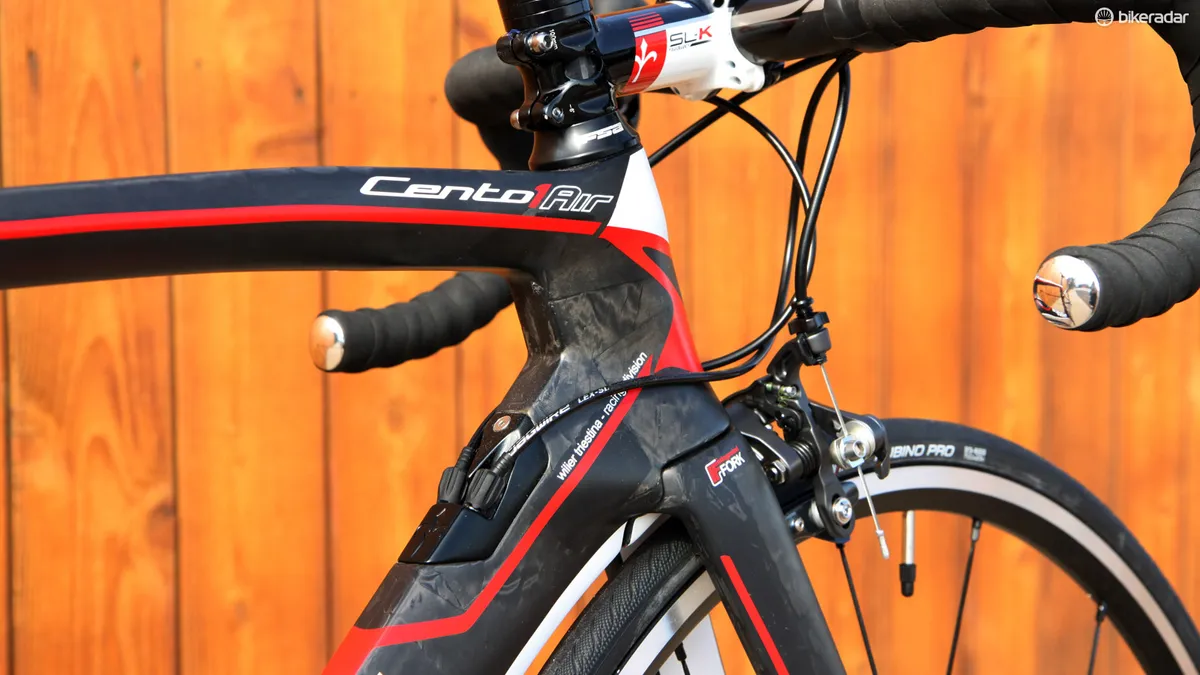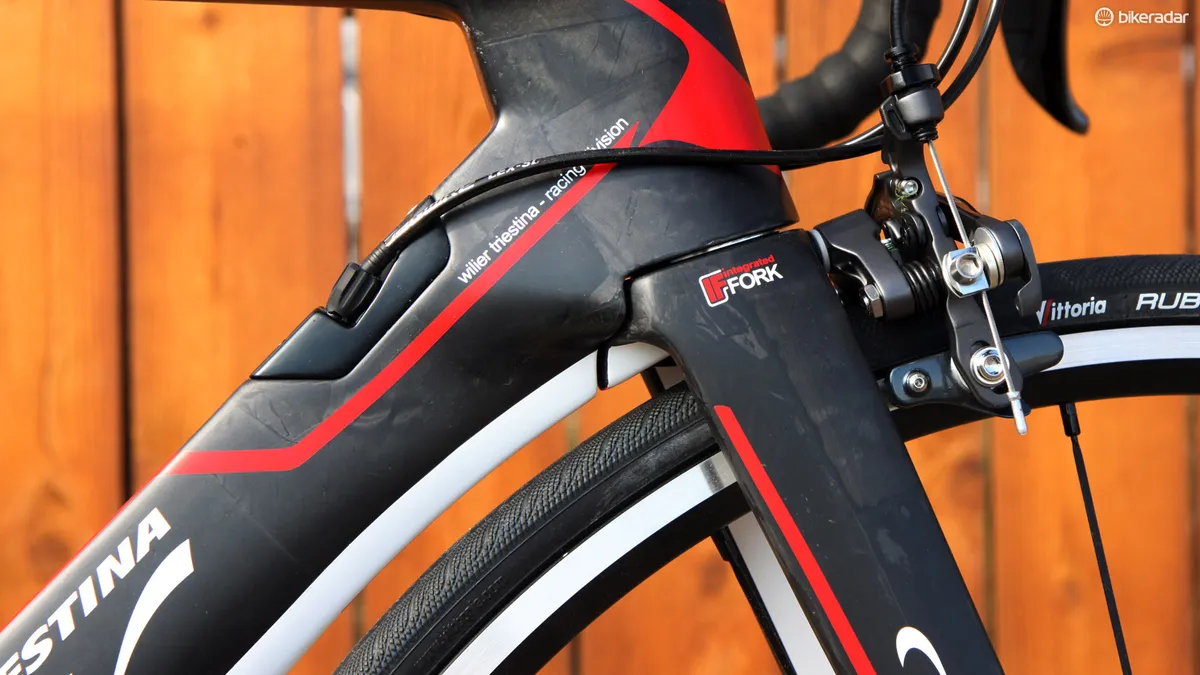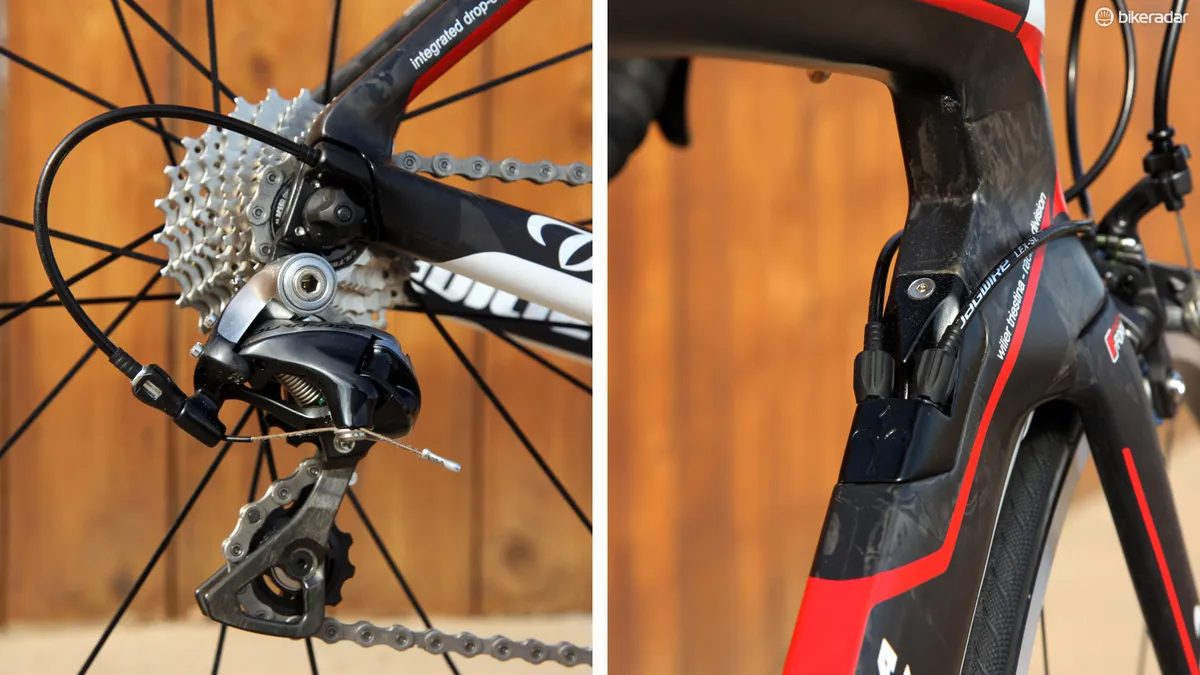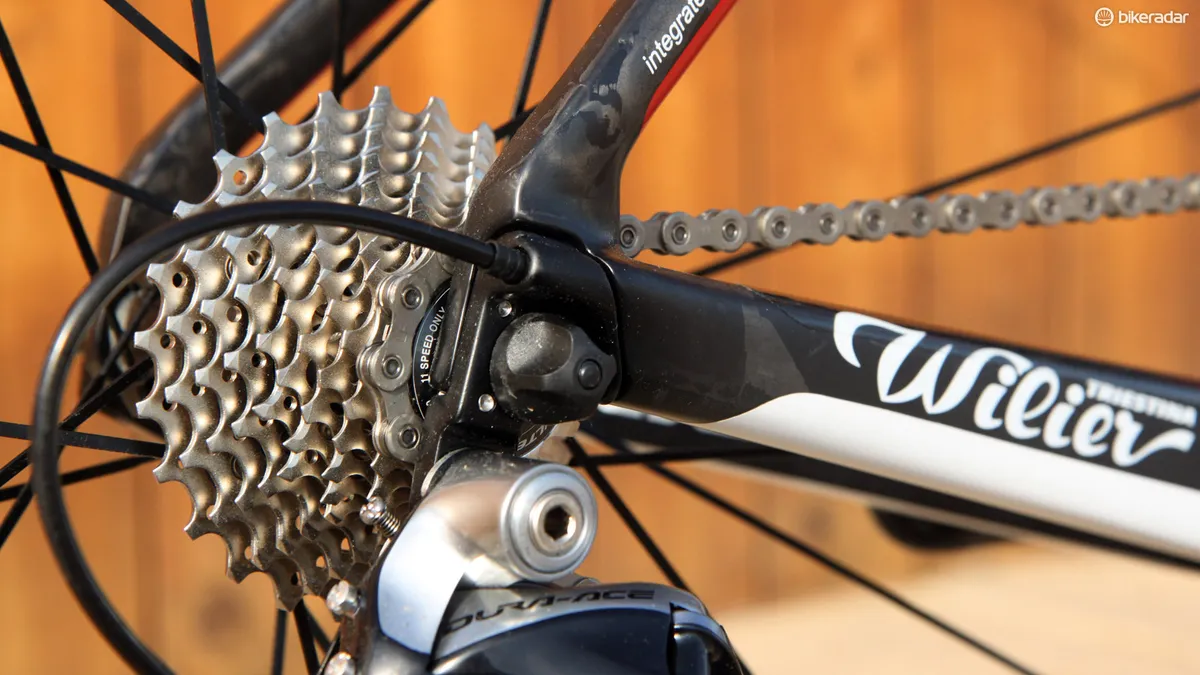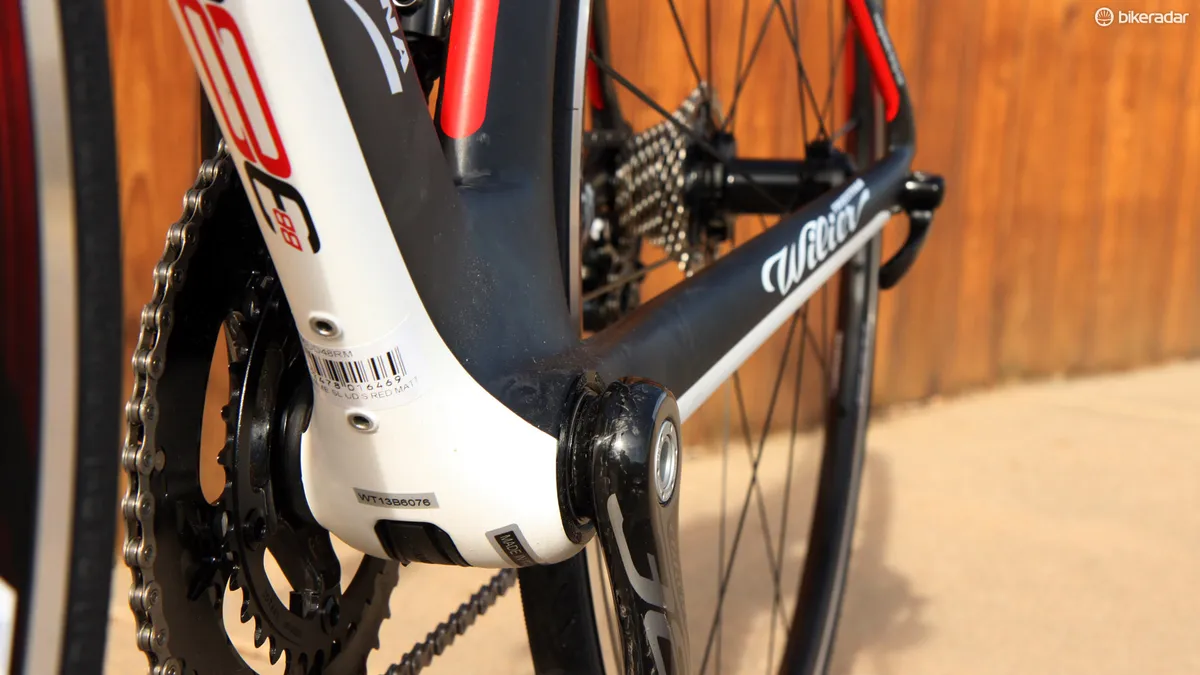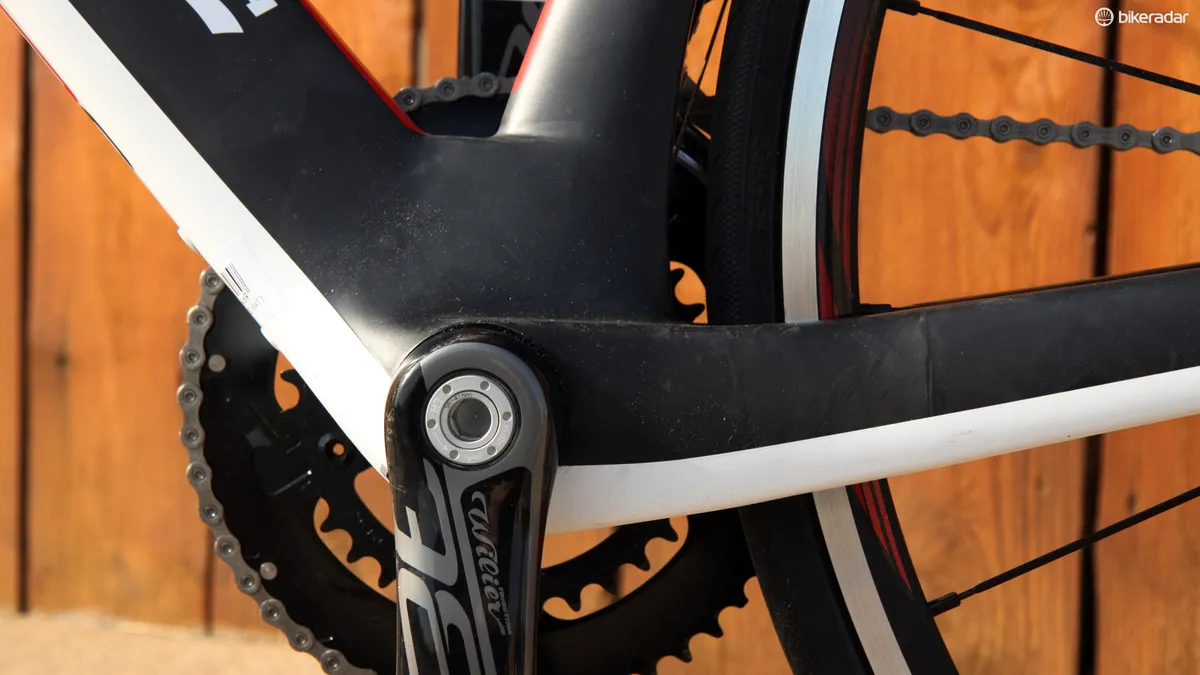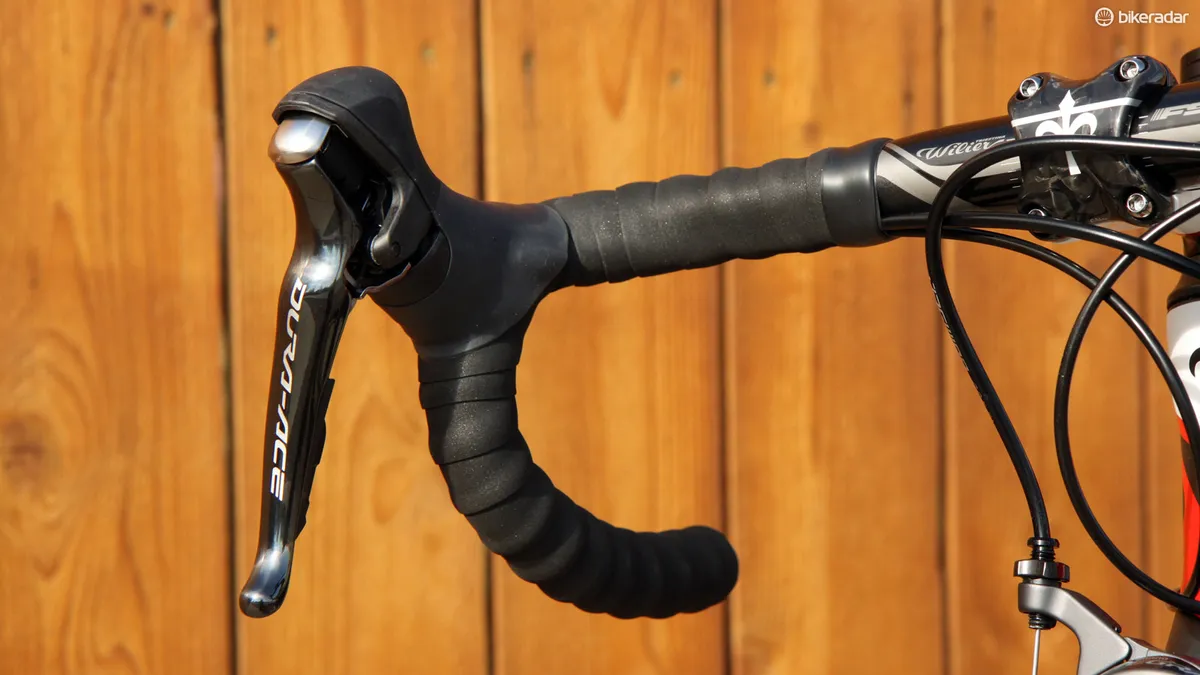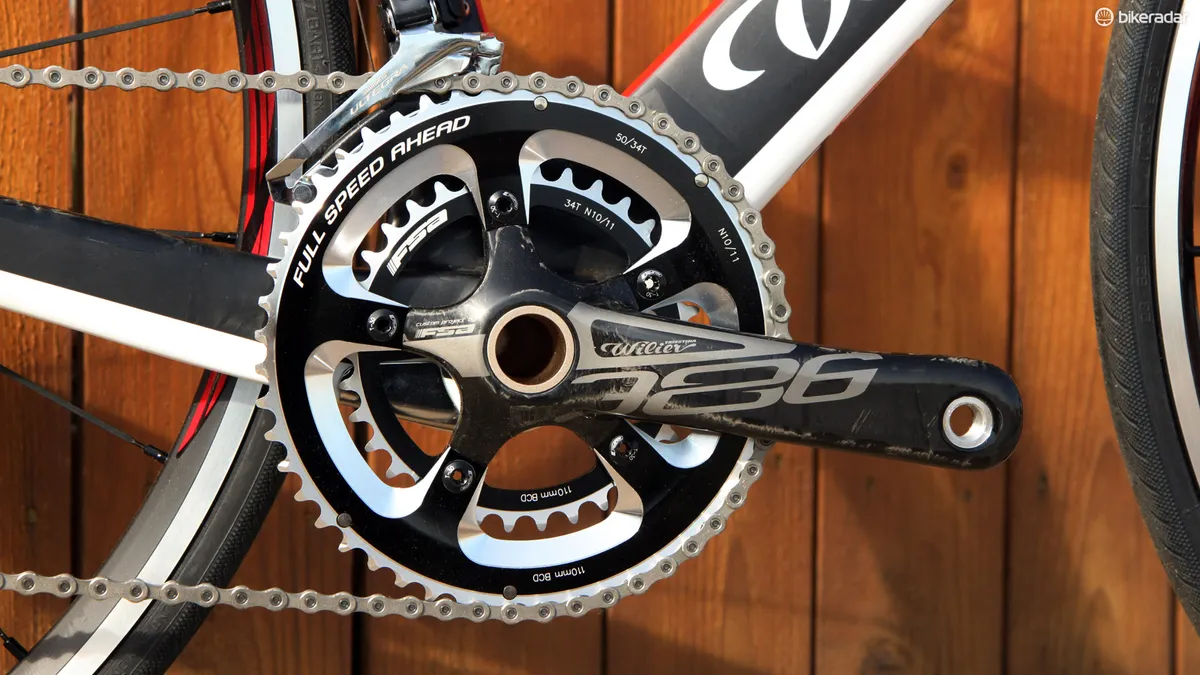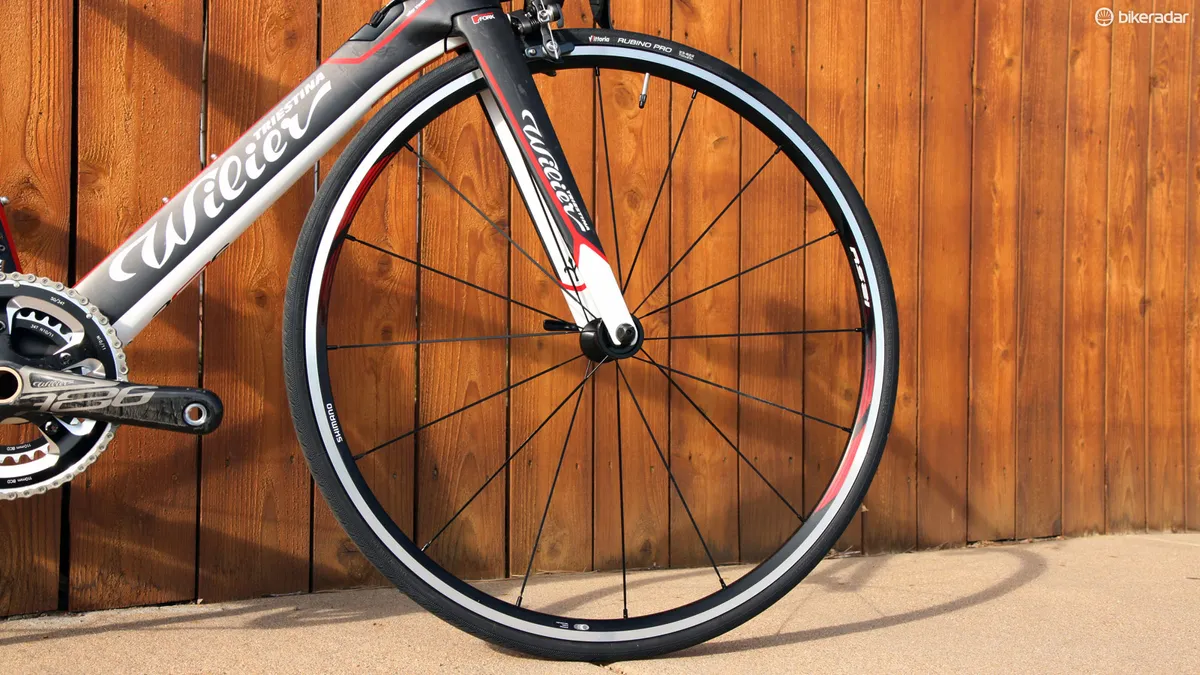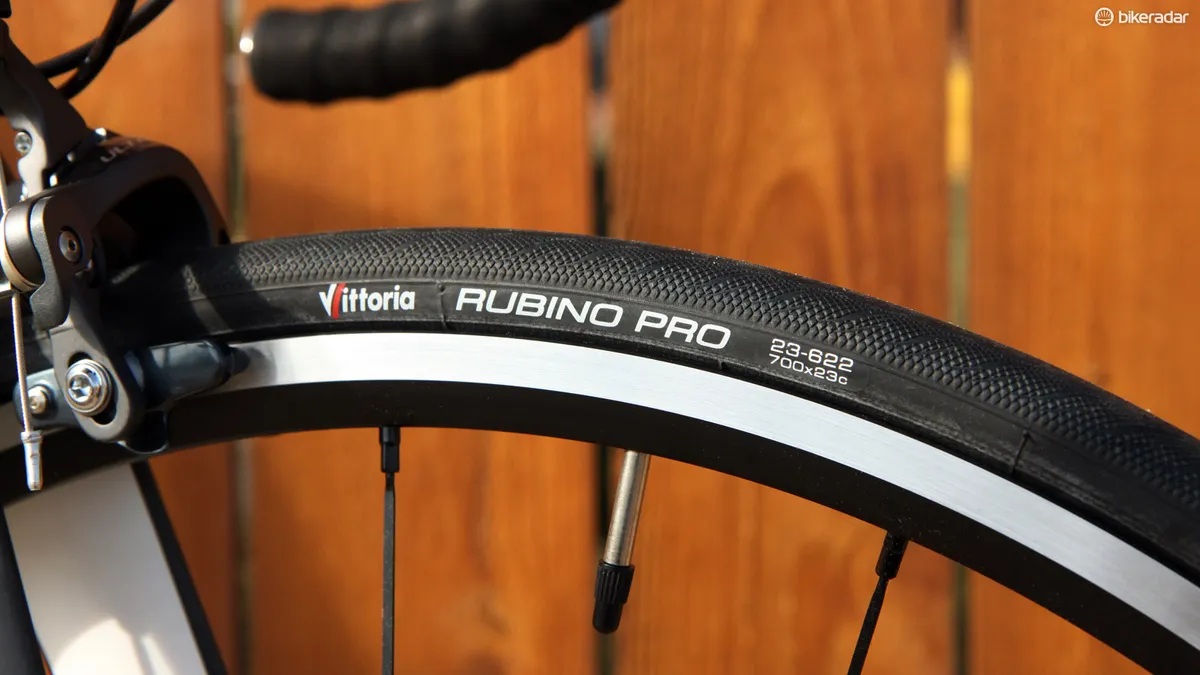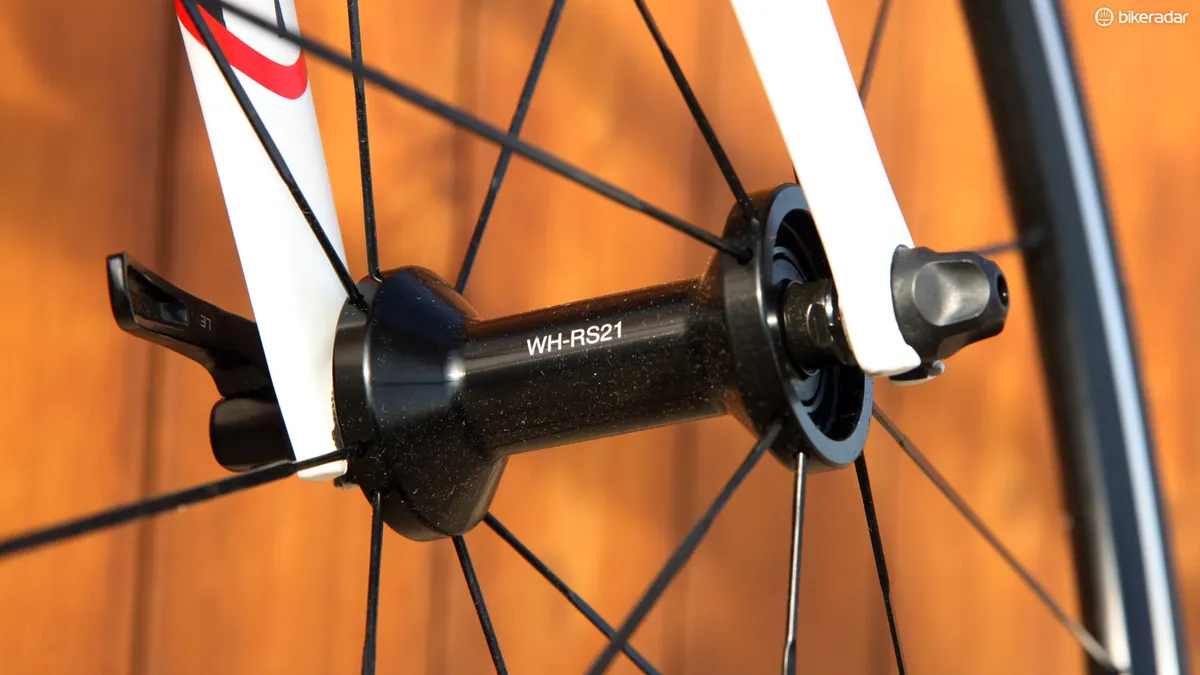The Wilier Triestina Cento1AIR uses the same proven geometry as the Cento1SR all-rounder but borrows more heavily from the TwinBlade time trial bike's bag of aero tricks. The result is a fetching aero road machine with great handling but also a few compromises made in the name of speed.
- Highs: Speedy shape, fantastic handling
- Lows: So-so ride quality, average frame stiffness, eclectic spec
- Buy it if: You're after an Italian-branded aero road bike and are willing to spec it yourself

Aero shaping is featured throughout the frame
Ride and handling: brilliantly nimble, but on the firm side
Designed with aerodynamic performance first and foremost, the Cento1AIR bears some big changes relative to the Cento1SR we tested last year: specifically, a deeper seat tube and matching telescoping carbon seatpost, a narrower down tube, more knife-edged fork blades, and a more compact rear end with seatstays that are offset quite a distance from the top tube. In some ways, the Cento1AIR is a road-going version of Wilier's full-blown TwinBlade TT machine.
Taken in total, the Cento1AIR is certainly sleeker than the SR with a smaller frontal area and virtually every important cross-section wearing some sort of aero profile. As it turns out, it also seems to be faster on the road, too, with our test sessions consistently showing marginally reduced course times compared with a decidedly non-aero long-term test bike we recently wrapped up.
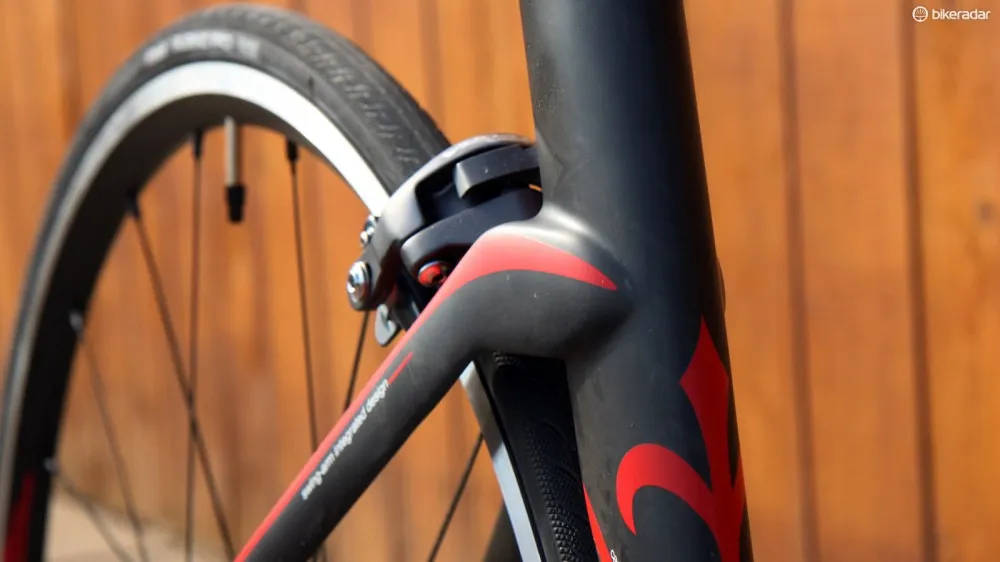
Seat stay shaping is borrowed from the TwinBlade time trial bike
That apparent extra speed does come at a cost, though. Whereas we relished the Cento1SR's fantastically efficient feel and surprisingly agreeable ride quality, the Cento1AIR's reduced tube widths and deeper section profiles exact a tangible penalty. The frame is far from soft but it's definitely not as stout under power as the SR, nor is it as comfortable with a ride that's quite firm, especially on bigger bumps. The stock rubber doesn't help, either (more on that later).
The SR's fantastic handling and fit are wholly carried over, however, with nimble reflexes and quick turn-in characteristics and yet still sufficient stability to feel confident in a full tuck at 80km/h (50mph). As the stack and reach numbers are also identical, we were easily able to set ourselves up in a comfortably long and low position for fast cruising.

The fork crown is blended well into the surrounding head tube and down tube
Frame: Sleek lines and clever touches
Wilier has certainly gone to great lengths to give the Cento1AIR a speedy look, and there's little question as to the frameset's intentions – it's meant to go fast. Truncated pseudo-airfoil profiles are used on the down tube, seat tube, and telescoping seatpost while the seatstays and fork blades wear more traditionally narrow shapes. Although the head tube still envelops a relatively big 1 1/8-to-1 1/4in tapered steerer, it necks down into an hourglass profile in the middle, plus the fork crown is so well integrated into the surrounding tubes that you hardly even notice – all you see is smooth transitions.

Blunt trailing edges have fast become the norm for aero frames
Although not as stiff as the Cento1SR, the AIR nevertheless includes a few features designed to bolster the bottom half of the bike. In particular, Wilier once again uses the extra-wide and oversized BB386EVO bottom bracket shell dimensions that the company helped pioneer in 2011. Unlike on the SR, though, only the chainstays make use of that extra real estate – but they're very widely set and quite broad to keep the back end from wagging.
Also borrowed from the Cento1SR is the neat convertible internal cable routing layout, which features a removable 'cap' on the top of the down tube and an interchangeable rear derailleur hanger that integrates the exit port for the housing or wire. In mechanical form, the top tube cap has barrel adjusters for the derailleur lines built right in so there's no need for unsightly inline adjusters. These might be a little tough to turn but we appreciated them nonetheless.

The chainstays are pushed out to the edges of the BB386EVO bottom bracket shell but the down tube and seat tube are comparatively narrow
Overall, it's quite a slick arrangement and it isn't a nightmare to deal with for DIYers, either.
The routing for the internally run rear brake could use a bit of work, however, as the rear section of housing exits at the top of the top tube and then has to snake down quite a bit since the seat stays are offset so far down. Functionally it works just fine but it’s a bit inelegant.
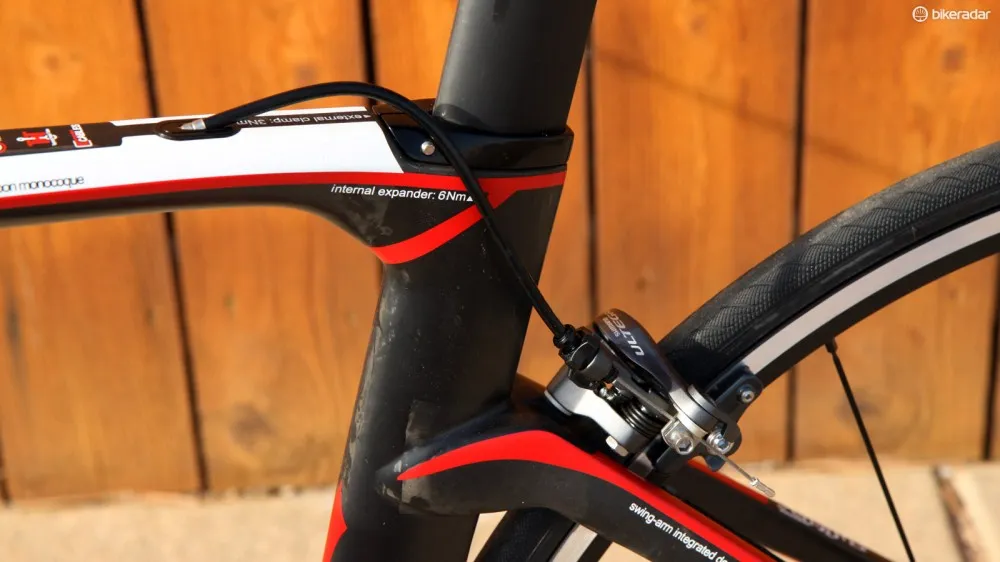
This could be viewed as nitpicking but the rear brake routing seems a bit inelegant
Speaking of elegance, Wilier has done a good job blending the seatpost clamp into the rest of the frame – well, the one you can see, that is. Somewhat annoyingly, the Cento1AIR actually has two mechanisms to secure the post: that external collar and a separate wedge hidden beneath. Both are apparently required to keep the post from slipping, and not only do they have separate torque specs but they require different Allen wrenches to operate.
Finally, there's the issue of frame weight. Wilier claims a frame and fork weight of 1,120g and 360g, respectively but, as we've often noticed in the past, those figures are rather optimistic. Our small-sized frame came in at 1,201g with all of the requisite bits attached (seatpost hardware, rear derailleur hanger, and cable routing hardware) and the fork hit the scale at 380g with a 200mm-long steerer but without the plug.

The asymmetrical chainstays are very tall
Equipment: Solid kit but still a little scattered
Our test bike came with Wilier's standard Shimano spec for this model, including a mix of Dura-Ace (shifters, rear derailleur), Ultegra (front derailleur, cassette, chain, brakes), and RS21 alloy clincher wheels. FSA also plays a major part with an SL-K BB386EVO carbon compact crankset, alloy SL-K stem and Wing Pro compact-bend handlebar (all with custom Wilier graphics for a visually cohesive look). Filling in the gaps are a custom Ritchey carbon seatpost and integrated headset, Vittoria Rubino Pro tires, and a Selle San Marco Concor saddle – again, with custom graphics.
Actual weight for the complete ensemble is 7.62kg (16.80lb) without pedals.

Custom graphics lend a nicely cohesive appearance
We had no issues whatsoever with the Shimano transmission, which – as expected – shifted exceptionally smoothly and consistently, and ran quietly. Kudos to Wilier, too, for including the Shimano chain instead of choosing a cheaper third-party brand as many others do. Brakes were strong and easy to control as well with excellent lever feel.
Given the speed-oriented focus of the bike, however, much of the rest of the spec feels a little out of place.
Shift performance on the FSA SL-K BB386EVO crankset was very good but we occasionally ran out of gear with the 34/50-tooth compact chainrings when heading downhill. Moreover, Wilier pairs those climbing-friendly rings with a disparately tight 11-25T cassette so we at times wished for easier ratios when climbing, too. Given the huge assortment of gears now available with 11-speed cogsets, a more logical choice in our minds would be a mid-compact 36/52-tooth chainring combination with an 11-28T cassette, which would provide a greater spread overall while still keeping the steps between individual rear cogs reasonably tight.
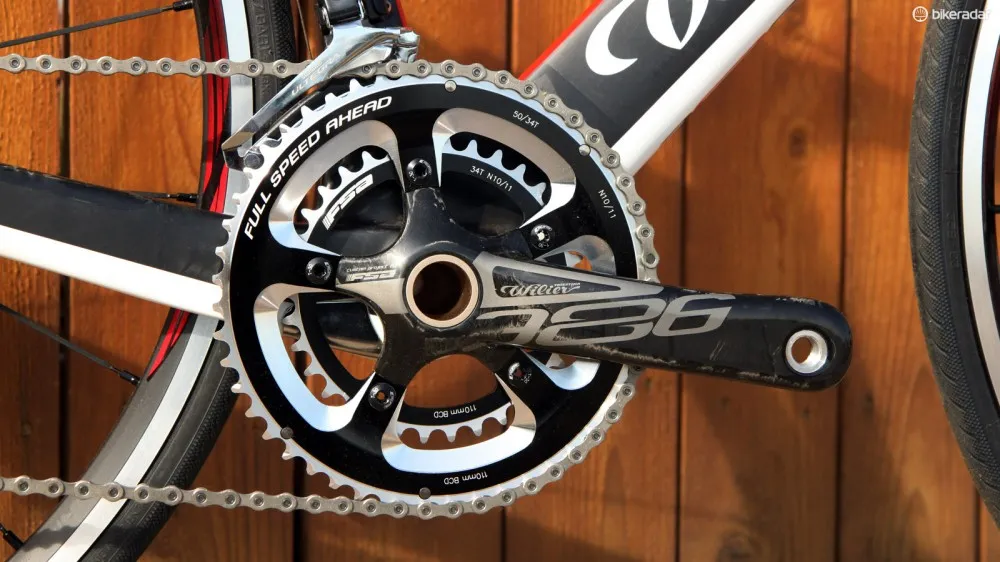
The compact gearing seems a little out of place for an aero machine
Similarly, while we understand Wilier's decision to spec inexpensive Shimano RS21 clinchers in an effort to keep the bike's overall price reasonable, their shallow section makes little sense on what's supposed to be a speedy aero frame. Much as we like the RS21s for their durability and serviceability, they're also quite heavy at nearly 1,800g per pair and very narrow with a 15mm internal rim width.
Making matters worse are the stock Vittoria Rubino Pros, whose stiff casings yield a harsh and lifeless ride quality with mediocre grip.
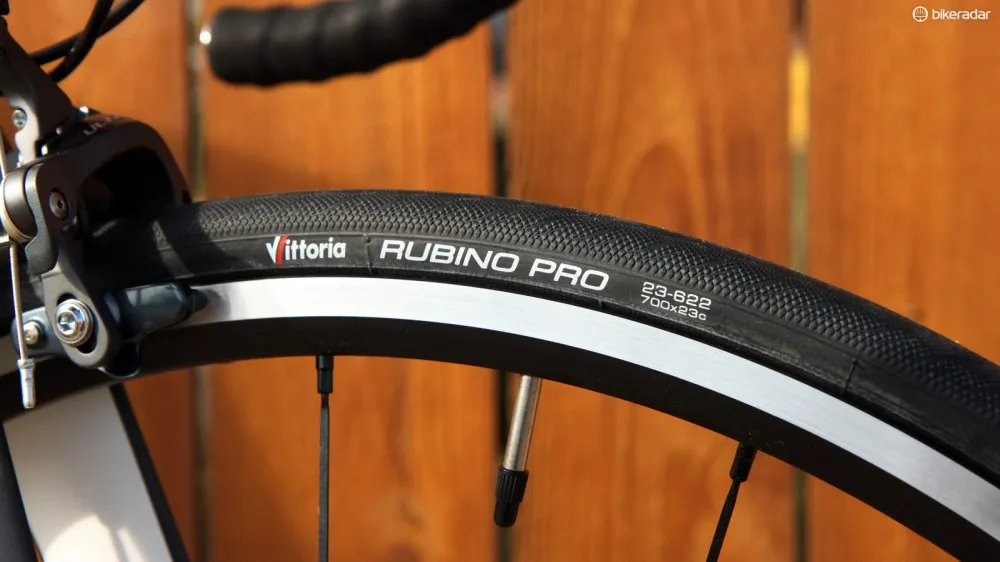
The stock Shimano RS21 wheels, shod with Vittoria Rubino Pros, are fine for training but are still disappointing given the potential of the frame
Wilier does offer HED's very speedy Jet 6 FR wheels as an optional upgrade (US only) but even then, there's little incentive to do so because they aren't discounted at all relative to retail cost. Either way, the Cento1AIR chassis deserves better rolling stock than what is provided here.
Finally, touch points are always personal issues but both the handlebar and saddle raised eyebrows as well. While comfortable, the compact-bend bar makes little sense given the bike's focus on speed as there's essentially no effective difference in rider position between the hoods and drops. And although the Concor saddle looks great, its very classic shape is very narrow and highly rounded, putting a lot of pressure on vulnerable soft tissue. Traditionalists might not have an issue with it but anyone who tends to prefer anything even remotely more modern will have a hard time here.

The compact bend is comfy but there's little position change between having your hands on the hoods versus the drops
The final word
Wilier Triestina has done a very good job on the Cento1AIR frameset, which during our test period has proven to be reasonably speedy and handles very well. So long as you're comfortable with the firm ride and middle-of-the-road frame stiffness, it strikes us as an excellent choice if you're looking for an aero road bike with some sort of Italian pedigree.
That said, the stock spec has too many oddities to ignore – so if the Cento1AIR strikes your fancy, we'd recommend going with a custom build instead.
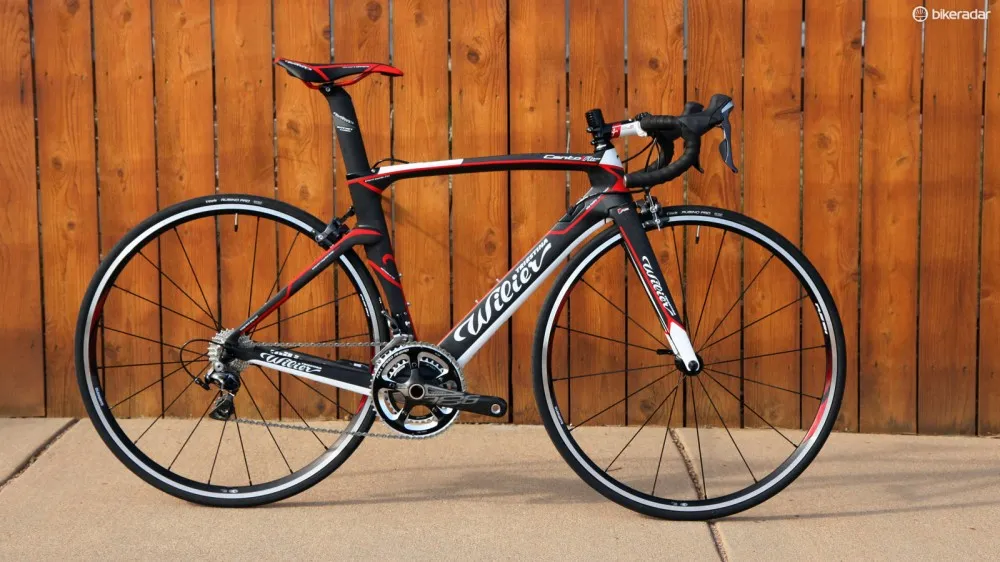
Complete bike specifications
- Frame: Wilier Triestina Cento1AIR
- Fork: Wilier Triestina Cento1AIR
- Headset: Ritchey Pro Logic Zero, 1 1/8-to-1 1/4in tapered
- Stem: FSA SL-K for Wilier
- Handlebar: FSA Wing Pro for Wilier
- Tape: Wilier cork
- Front brake: Shimano Ultegra BR-6800
- Rear brake: Shimano Ultegra BR-6800
- Brake levers: Shimano Dura-Ace STI Dual Control ST-9000
- Front derailleur: Shimano Ultegra FD-6800
- Rear derailleur: Shimano Dura-Ace RD-9000
- Shift levers: Shimano Dura-Ace STI Dual Control ST-9000
- Cassette: Shimano Ultegra CS-6800, 11-25T
- Chain: Shimano Ultegra CN-6800
- Crankset: FSA SL-K BB386EVO for Wilier, 50/34T
- Bottom bracket: FSA SL-K BB386EVO
- Pedals: n/a
- Wheelset: Shimano WH-RS21-CL
- Front tire: Vittoria Rubino Pro, 700x23c
- Rear tire: Vittoria Rubino Pro, 700x23c
- Saddle: Selle San Marco Concor for Wilier
- Seatpost: Ritchey Superlogic Carbon for Wilier

